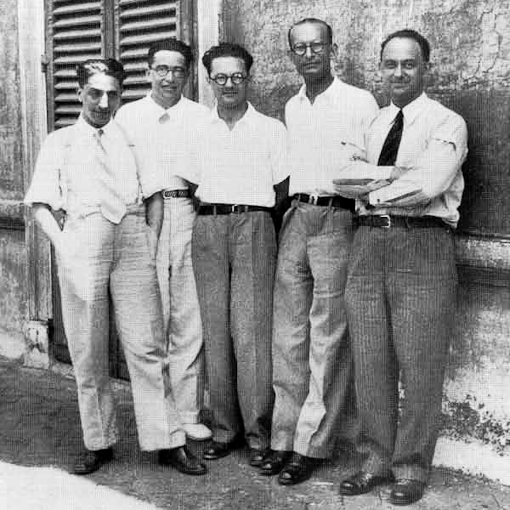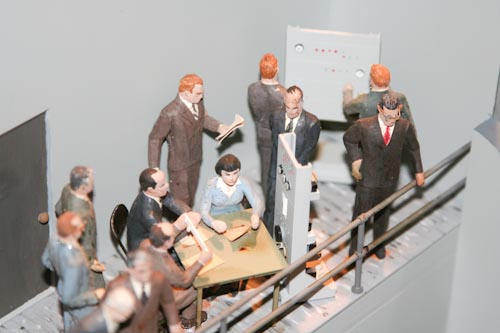Enrico Fermi’s Influence in Science

Enrico Fermi (far right) with the Via Panisperna boys. Enrico’s team of student-colleagues is named for the lab in Rome where they carried out groundbreaking research bombarding elements with slow neutrons, to learn about basic properties of matter. For this work, Enrico won the Nobel Prize in 1938. Photo: Unknown
Enrico Fermi’s influence in science extends in multiple directions: from his work as a theorist and experimentalist in physics, to his profound influence as a mentor and team-builder. Many who went on to achieve their own Nobel Prizes had brushed shoulders with Enrico. Jerome Friedman, Professor Emeritus, MIT, and one of those plucky ones, says Fermi’s most profound contribution to us all is simply the promulgation of order of magnitude calculations (aka Fermi Questions).
Special Forum as part of Annual American Physics Society (APS)/American Association of Physics Teachers (AAPT), February 2010: Remembering Enrico Fermi. Highlights of stories shared by physicists who knew him.
Enrico Fermi’s Impact on Science: Address given by Dr. John H. Marburger III at the Italian Embassy, Washington, D.C., Centennial Celebration of the Birth of Enrico Fermi, 2001.
Enrico Fermi’s Contributions to Science (source: Fermilab)
“It is imaginable — hypothetical situations are by definition hard to evaluate objectively — that some other physicist (or group of physicists) might have obtained the research results that Fermi achieved while in Chicago (including the first nuclear chain reaction), but it defies the bounds of human inspiration to speculate that any other man or woman might have played Fermi’s role as a teacher in the broader sense of this term. Through the influence of his students, Fermi effectively revolutionized the training of students in the United States and one hopes in the whole world.” Valentine Telegdi, physicist.
“Another sign of Fermi’s strong positive influence on his students and others is the large number who became Nobel Prize winners (Fig. 3). Of course, the Fermi students received their Ph.D. degrees before performing their Nobel Prize research. There were (1) Lee and (2) Yang for the correct theory of nonconservation of parity, (3) Owen Chamberlain and (4) Emilio Segré for the discovery of the antiproton, (5) Jack Steinberger for the muon-flavored neutrino, and (6) Jerry Friedman for measurements of the quark in electroproduction. (Jerry was an active Fermi student, but Fermi died before Jerry earned his Ph.D.) (7) Dick Garwin was also a student of Fermi and if the Nobel Prize had been awarded for the experimental discovery of parity violation in pion-muon and muon-electron decay (as it should have been), it would have been shared by him. (8) Jim Cronin was formally a grad student of Sam Allison (who was very busy as director of the institute). However, his office was next door to Fermi’s office, and Jim frequently visited with his close neighbors and also attended Fermi’s courses and Fermi student group meetings. It was agreed that Fermi would help out with Allison’s students. Cronin received the Nobel Prize for the discovery of CP violation. (9) Maria Mayer was not a Fermi student, but she was a faculty member who consulted closely with Fermi. She gives credit to Enrico in her paper on the nuclear shell model for supplying key ideas such as using a spin-orbit interaction to explain the mysterious nuclear magic numbers that she had discovered (but couldn’t explain). I think it is fair to say that the shell model is a joint product of the two of them. One of Fermi’s “trainees” from the Italian days was (10) Hans Bethe as a postdoc. Hans made many discoveries including the thermonuclear energy source of stars. This is a total of 10 followers of Fermi receiving Nobel Prizes in a short period of time. I don’t know of any other physicist who has left such a strong mark on his followers. A possible eleventh is Murray Gell-Mann, who joined Fermi on the Chicago faculty as a young instructor. Millie Dresselhaus has told me that while at a party in his house, Fermi had patted Murray on the back and predicted that he would become a Nobel Prize winner. A more recent Nobel Prize winner who also had spent a year or two working with Fermi is (12) S. Chandrasekhar. Depending on how we count, Fermi training led to 10, 11, or 12 Nobel Prizes. I estimate the probability that an existing Nobel Prize winner in physics “give birth” to another winner is less than 1/10. So if this is purely random, the probability of one winner giving birth to 10 other winners would be one-tenth to the 10th power or one in 10 billion, which is essentially impossible. The explanation is that Fermi was very creative and the world’s best trainer or teacher of physics. Also, his known talent and pleasant personality attracted the best students. According to the talk given by Lincoln Wolfenstein, all the Chicago theory students would have preferred to be Ph.D. students of Fermi.” from Enrico Fermi: Master Scientist by Jay Orear.

Partial view of model of the first atomic pile. Enrico Fermi, group director, sits holding the sliderule he used for all his calculations. Across the table sits Leona Marshall, the only woman scientist on the team building the first-ever self-sustaining nuclear chain reaction. The model resides at the Museum of Science and Industry, Chicago, IL within walking distance of the underground squash court where the successful experiment was completed on December 2, 1942. Photo: Olivia Fermi © 2010.



